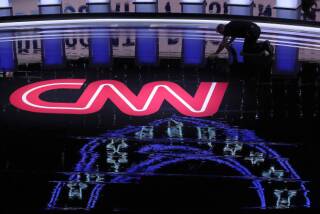A&E; Narrows the Culture Gap, CNN Turns a Heavyweight 10
- Share via
Cable’s Arts & Entertainment network, in little more than six years of operation, has managed to become a sort of junior public TV--with commercials.
To say that A&E; is presently a bona-fide alternative to PBS--even taking the public-TV system’s flaws into account--would be going too far. For one thing, the frequency and seemingly arbitrary insertion of A&E; commercials is just exasperating. A recent showing of that fine John Sayles film “Matewan,” for example, found A&E; bringing down a commercial break on a climactic final sequence like a guillotine. A network that purports to exalt art should respect its integrity.
In other ways, however, the gap separating PBS and A&E; may be narrowing.
Although still short on first-run fare, A&E; offers many of the same types of programs--let’s stop mincing words and call them “highbrow”--available on PBS.
And some that are not found on PBS.
Most dramatically, that includes the cable network’s own month-old “Arts & Entertainment Revue,” a weekly hour (airing at 5 and 9 p.m. Fridays, 3 p.m. Saturdays and 8 a.m. Sundays) that nourishes your mind with a cultural menu not unlike the old “Omnibus” series that ran on CBS and ABC in the mid-1950s.
“Arts & Entertainment Revue” is a show that PBS should have done.
Produced by Susan Lester and Av Westin and hosted by the gifted Eric Burns (who previously co-hosted “By the Year 2000” on KCET), this is a very good-getting-to-be-grand program that has no twin or even a close cousin elsewhere on TV. To call it “Entertainment Tonight” with a brain is either to overvalue the syndicated “Entertainment Tonight” or to undervalue “Arts & Entertainment Revue.”
Actually, there is no similarity beyond the title. Here is a show that leisurely explores and celebrates creativity, in part by turning creators themselves into informal correspondents, as in last week’s rich profile of Mandy Patinkin. The reporter was author/singer/deejay Jonathan Schwartz.
“Arts & Entertainment Revue” has been a Rolodex of delights, whether a bit of a play or Morley Safer reading portions of his book, “Flashbacks: On Returning to Vietnam,” or comments by Sid Caesar and Imogene Coca juxtaposed with their brilliant sketches from “Your Show of Shows.” There’s genius here, and wit and vibrancy.
Just as “Nightline” and Ted Koppel were made for each other, so, in a lower-case way, are “Arts & Entertainment Revue” and Burns, whose ability to make unforced, intelligent conversation with guests sets the tone for this show. More than anything, however, it’s the performance aspect that defines “Arts & Entertainment Revue.”
Not everything works. If some authors wrote as poorly as they read their own writing on this program, for example, they wouldn’t even be published.
Yet this is a very special hour and a sweet way to cap a week. A quote from that singing, dancing little person on ABC’s “Twin Peaks” applies here: “There’s music in the air.”
CNN has just celebrated its 10th birthday, noting one of the most incredible success stories in the history of television. The visionary Ted Turner’s almost-all-news cable network is TV’s Rocky, an underdog, 90-pound weakling grown into a brawny, thick-necked heavyweight with 16-inch biceps.
Measuring today’s CNN against the infant CNN--the one that ABC, CBS and NBC regularly ridiculed before later growing to respect and fear it--is just, well, boggling. It’s something to keep in mind before making snap negative judgments about weird-looking toddlers like the three-hour news block that KCAL Channel 9 initiated three months ago.
CNN has become not only one of this nation’s institutions but also one of the world’s. The one thing that you can count on while traveling abroad is CNN, whose straight news programs are beamed to 90 nations.
No wonder that Bobbie Battista may have closed in on the globally syndicated Lucille Ball as the world’s most recognizable face during her recently ended seven-year stint as “Headline News” anchor. Although relatively unknown in the United States, Battista--who now co-anchors CNN’s “World Day” and “Newshour” programs--got famous internationally by being on the air at peak viewing times in other nations where TV diets are sparse.
According to CNN executive vice president Ed Turner, a CNN executive was in a cab in Berlin recently when the driver noticed the network logo on his tote bag. “Oh, CNN,” the cabbie said. “I learned to speak English listening to Bobbie Battista.”
In the United States, CNN has become indispensable both as a network of record for such epic events as the Bush-Gorbachev summit and as the network that reacts speediest to breaking news. What’s more, CNN sometimes covers things that may not rank high on a news scale but are interesting slices of life that make up the American pie.
As an industry, cable has a spotty record in providing diversity. Without a doubt, however, CNN has become the 911 number for finding out what’s happening in the world.
It’s also a network that can make you mad, having been known to overcover events merely because it is a news network. And raw, unedited footage still finds its way onto CNN during some breaking stories for no other apparent reason than it’s available--a dangerous practice. Moreover, not all CNN stars are on camera because of their news pedigrees: Witness the controversial hiring of Texas judge Catherine Crier--a news neophyte--as “The World Today” co-anchor with veteran Bernard Shaw.
TV being TV, it was inevitable that CNN would nurture its own news celebrities. Unlike its older counterparts, however, this is not a network where news anchors and reporters are the stars. As Hank Whittemore, author of a just-published biography on CNN, notes, on this network “the news is the star.”
More to Read
The complete guide to home viewing
Get Screen Gab for everything about the TV shows and streaming movies everyone’s talking about.
You may occasionally receive promotional content from the Los Angeles Times.






